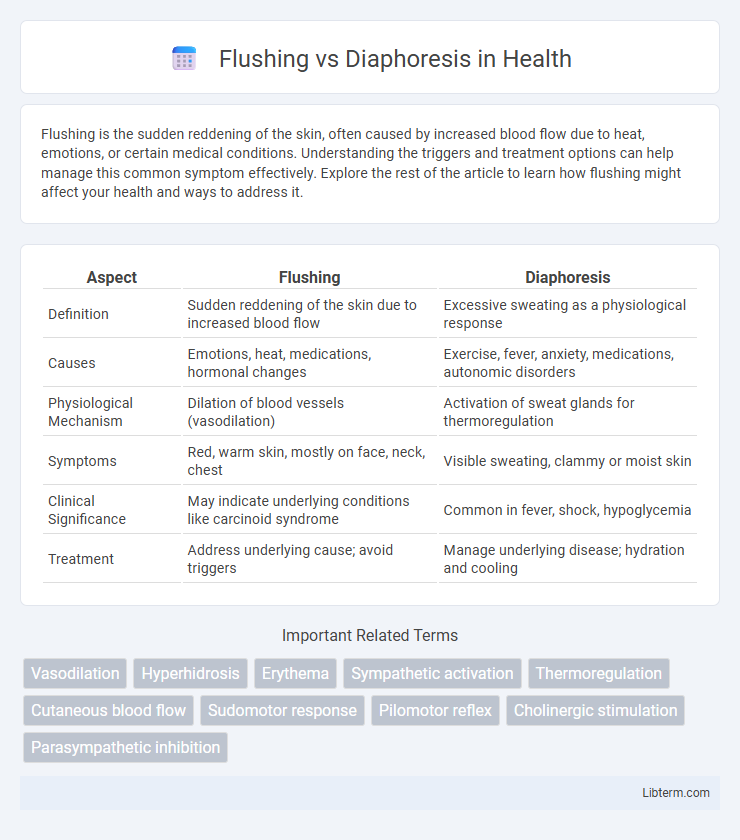Flushing is the sudden reddening of the skin, often caused by increased blood flow due to heat, emotions, or certain medical conditions. Understanding the triggers and treatment options can help manage this common symptom effectively. Explore the rest of the article to learn how flushing might affect your health and ways to address it.
Table of Comparison
| Aspect | Flushing | Diaphoresis |
|---|---|---|
| Definition | Sudden reddening of the skin due to increased blood flow | Excessive sweating as a physiological response |
| Causes | Emotions, heat, medications, hormonal changes | Exercise, fever, anxiety, medications, autonomic disorders |
| Physiological Mechanism | Dilation of blood vessels (vasodilation) | Activation of sweat glands for thermoregulation |
| Symptoms | Red, warm skin, mostly on face, neck, chest | Visible sweating, clammy or moist skin |
| Clinical Significance | May indicate underlying conditions like carcinoid syndrome | Common in fever, shock, hypoglycemia |
| Treatment | Address underlying cause; avoid triggers | Manage underlying disease; hydration and cooling |
Understanding Flushing and Diaphoresis
Flushing involves sudden, visible reddening of the skin often linked to increased blood flow, commonly triggered by emotions, heat, or certain medical conditions. Diaphoresis refers to excessive sweating usually caused by stress, fever, or underlying health issues like infections or heart problems. Differentiating these symptoms aids in diagnosing conditions such as carcinoid syndrome, autonomic dysregulation, or menopause.
Key Differences Between Flushing and Diaphoresis
Flushing is characterized by a sudden redness of the skin, particularly on the face and neck, caused by increased blood flow due to vasodilation, often triggered by emotions, medications, or medical conditions such as carcinoid syndrome. Diaphoresis, on the other hand, involves excessive sweating resulting from autonomic nervous system activation, commonly associated with conditions like fever, anxiety, hypoglycemia, or myocardial infarction. While flushing is primarily a vascular phenomenon evident as skin discoloration, diaphoresis is a sweat gland response that leads to moist, clammy skin.
Common Causes of Flushing
Flushing commonly results from causes such as emotional stress, heat exposure, alcohol consumption, and certain medications like niacin or calcium channel blockers. Medical conditions including rosacea, carcinoid syndrome, and menopause also frequently trigger flushing episodes. Differentiating flushing from diaphoresis is essential, as diaphoresis involves excessive sweating typically linked to fever, hypoglycemia, or autonomic dysfunction.
Common Causes of Diaphoresis
Diaphoresis, characterized by excessive sweating, commonly results from conditions such as hyperthyroidism, infections, hypoglycemia, and menopause, distinguishing it from flushing, which involves redness of the skin typically caused by vasodilation. Unlike flushing, which may be triggered by emotional stress or alcohol consumption, diaphoresis often signals underlying systemic issues like sepsis or cardiovascular events. Accurate identification of diaphoresis causes is crucial for effective diagnosis and treatment, emphasizing the need to evaluate symptoms in context with patient history and clinical findings.
Symptoms Associated with Flushing
Flushing is characterized by sudden redness and warmth primarily on the face, neck, and upper chest, often accompanied by a sensation of heat and visible vascular dilation. Symptoms associated with flushing include transient erythema, a feeling of warmth, possible sweating, and sometimes palpitations or headaches. Unlike diaphoresis, which involves excessive sweating without prominent redness, flushing's hallmark is the pronounced vascular response leading to noticeable skin color changes.
Symptoms Associated with Diaphoresis
Diaphoresis is characterized by excessive, abnormal sweating often linked to underlying medical conditions such as infections, cardiovascular disorders, or endocrine imbalances. Symptoms associated with diaphoresis include clammy skin, cold sweat, and sometimes night sweats, which can indicate systemic illness or autonomic nervous system activation. Unlike flushing, which involves redness and warmth due to increased blood flow, diaphoresis primarily involves moisture without significant skin color changes.
Diagnostic Approaches for Flushing and Diaphoresis
Diagnostic approaches for flushing primarily involve evaluating patient history, physical examination, and laboratory tests such as measuring serum tryptase, plasma histamine levels, and 24-hour urine 5-HIAA to identify carcinoid syndrome or mastocytosis. For diaphoresis, diagnostics focus on ruling out underlying causes like infections, hyperthyroidism, hypoglycemia, or malignancies through comprehensive metabolic panels, thyroid function tests, and imaging studies including chest X-rays or CT scans. Both conditions often require tailored testing based on associated symptoms and suspected etiologies to guide accurate diagnosis and treatment.
Medical Conditions Linked to Each Condition
Flushing is often linked to medical conditions such as carcinoid syndrome, rosacea, and menopause, indicating abnormal vasodilation and increased blood flow to the skin. Diaphoresis, or excessive sweating, is commonly associated with conditions like hyperthyroidism, infections, myocardial infarction, and hypoglycemia, reflecting autonomic nervous system activation or systemic stress responses. Understanding these differing pathophysiologies helps clinicians distinguish between underlying diseases and tailor appropriate management strategies.
Treatment Options for Flushing vs Diaphoresis
Treatment options for flushing primarily include antihistamines and corticosteroids to reduce inflammation and vascular dilation, while beta-blockers and serotonin antagonists are sometimes used for severe cases linked to carcinoid syndrome. Diaphoresis treatment focuses on addressing the underlying cause, such as hyperhidrosis which responds well to antiperspirants containing aluminum chloride, oral anticholinergics, or botulinum toxin injections. Both conditions may require lifestyle adjustments and symptomatic management depending on their etiology and severity.
When to Seek Medical Attention
Seek medical attention for flushing if it is sudden, persistent, accompanied by chest pain, difficulty breathing, or swelling, as these symptoms may indicate a serious allergic reaction or cardiovascular issue. Diaphoresis warrants urgent evaluation when it occurs with chest pain, severe weakness, confusion, or fever, suggesting possible heart attack, infection, or other critical conditions. Timely diagnosis and treatment are essential to address underlying causes and prevent complications.
Flushing Infographic

 libterm.com
libterm.com